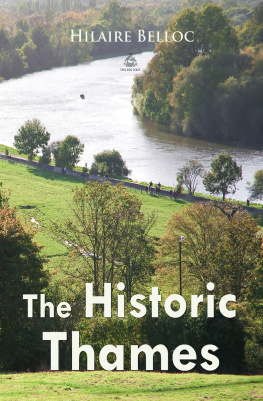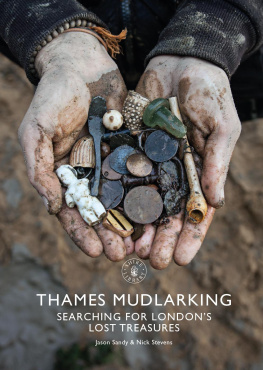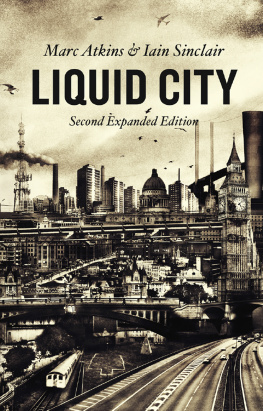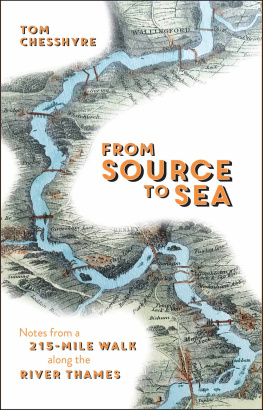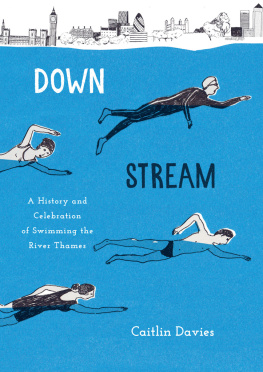Title Page
The Thames
A Cultural History
by
MICK SINCLAIR
Publisher Information
First published in 2007 by
Signal Books Limited
36 Minster Road Oxford OX4 1LY
www.signalbooks.co.uk
Digital Edition converted and distributed in 2011 by
Andrews UK Limited
www.andrewsuk.com
Mick Sinclair, 2007
The right of Mick Sinclair to be identified as the author of this work has been asserted by him in accordance with the Copyright, Design and Patents Act, 1988.
All rights reserved. The whole of this work, including all text and illustrations, is protected by copyright. No parts of this work may be loaded, stored, manipulated, reproduced or transmitted in any form or by any means, electronic or mechanical, including photocopying and recording, or by any information, storage and retrieval system without prior written permission from the publisher, on behalf of the copyright owner.
Cover Design: Baseline Arts
Production & Design: Devdan Sen
Cover Images: Peter Adams Photography/Alamy; Mayfair Picture Library; Darren Baker/istockphoto
Photographs and Images Mick Sinclair pp.40, 50, 100, 125, 147, 165, 195, 205, 214, 222, 228, 230, 251; Catriona Davidson pp.2, 4, 20, 22, 25; Alamy pp.xxii, 75, 87, 89, 202; Margaret Smeaton/istockphoto pp.i, 36; Ben Battersby/istockphoto p.x; Jon Tarrant/istockphoto p.xii; Graeme Purdy/istockphoto pp.34, 70; Sean Nel/istockphoto p.80; John Tate/istockphoto p.115; Dave Roberts/istockphoto p.190; Chris Schmidt/istockphoto p.198
Page numbers above refer to print edition of title.
Preface
The Thames is much more than a mere river and writing a book about it, as I discovered when it was too late to turn back, is much more than describing a body of water. In fact, I was often writing not so much the story of a river but what seemed an entire history of England, from the trading habits of Roman settlers and the role of Thames bridges in the civil war to the effects of industrialization and the impact of the Blitz.
Not that examining history as far back as it has been recorded - and sometimes even further - revealed the whole tale. Its surface may at times be frozen but the Thames never stops flowing; its waters and their surrounds document the present (think Canary Wharf or the Millennium Dome) as thoroughly as they do the past while also offering pointers to the future.
As activists activate, speculators speculate and environmentalists tangle with developers, the river itself is suddenly a focus of debate. Should regeneration necessarily include preservation? How many anchors embedded in the pavement are needed to suggest heritage on Londons riverside? Refreshingly less contentious are matters such as the upper rivers conservation of historic locks, the lengthening Thames Path, and the post-industrial (partial) greening of the Thames estuary, allowing the broadest sections of the river to be enjoyed with fresh air rather than toxic fumes for company. On the subject of company, I have to mention Fred Thacker, without whom the Thames would seem a very different river and any serious account of it would be much the poorer. Thackers three books of the early 1900s saved subsequent generations of Thames writers serious legwork in unearthing documents of the early river while his personal asides offer matchless insights.
Whether fiction or fact, several other books with the river at their heart deserve particular mention: Sydney R. Jones Thames Triumphant (1943) casts the waterway as a fixed reference point in the turmoil of the Second World War; William Morris News From Nowhere (1891) embraces a post-apocalypse England and takes us onto the Thames to view it; the real Thameside scenes of the late nineteenth century are described with revealing (if often unintentionally so) insights by the well-to-do gentlemen who authored The Royal River (1885). Jerome K.
Jeromes seemingly immortal Three Men in a Boat (1889) still brings easy laughs but at another level reflects an attitude to the river and its surrounds that, a hundred years on, might be seen (if only by me) as hardening into Iain Sinclairs Downriver (1991), an intense, abrasive and worrying book - for all the right reasons.
As should any account unhindered by mooring details and lock- keepers telephone numbers, mine describes the Thames as a source of power, a provider of livelihood and an object of pleasure, and above all as a waterway imbued with a cultural and historical meaning acquired over many centuries of human interaction.
Seen in this light, the Thames reveals itself to be less a river than a mirror, a reflection of who we are.
Introduction: A Symbolic River
And we came to realize more than ever that the Thames is the true symbolic river of England, the river that has nurtured within its embrace many of the people and systems, ideas, aims, and ideals, which in no small measure through the centuries have built up the character and trends of the race, reflected on the pages of ancient and modern history by deeds accomplished, some failures, and many triumphs.
Sydney R. Jones, Thames Triumphant, 1943
The River Thames should be a simple thing: a body of water that rises from the ground some three hundred feet above sea-level in a Gloucestershire meadow and flows for 215 miles downhill in a generally easterly direction until reaching the North Sea. Yet as Sydney R. Jones noted, albeit in the emotionally-charged atmosphere of an England at war, this is a river with a significance far greater than its mere physical form would suggest.
The Thames has been a source of sustenance, a provider of raw materials, a means of transport for kings, queens and commoners, linked rural England to the centres of national power as well as the markets of Europe and beyond, been a site for palaces and prisons, and seen the plots, conspiracies and political intrigues - from Magna Carta to the Profumo Affair - that have shaped the course of English history.
For generations, the river provided a living, and a lifestyle, for many on its course, be they the osier gatherers, eel-catchers and isolated lock- keepers of the upper river or the shipwrights and ferrymen, and later the dockers, of London. For almost as long as people have lived along its banks, the Thames has inspired novels, poetry and song, and since Victorian times it has been a major provider of pleasure and sport, originating the Oxford-Cambridge Boat Race, hosting regattas by the score, and still lined by countless rowing clubs and boatyards.
Watched over by grazing cows in quiet meadows and crossed by medieval bridges that once linked manor houses and monasteries, some sections have barely changed since the days horses pulled barges and transported Cotswold wool to market. By stark contrast, many other parts of the Thames have been, or are being, transformed almost beyond recognition. In London, the river has entered the twenty-first century as one of the capitals most discussed aspects: new architecture a feature of its banks; regeneration the buzzword of the riverside; new pathways making its course through the metropolis publicly accessible.
East of London along the Thames estuary, toxicity and pollution have been reduced and enabled the river to again be seen as a desirable natural asset. The potential of the Thames Gateway, a media-friendly term for the estuary and much around it, to become, despite political controversies and ecological concerns, the solution to south-east Britains housing crisis, confirms the continuing rediscovery of the river - and a growing affirmation of its contribution to the well-being of the nation.
Early History
Its course determined by successive ice ages and its name and character by successive invaders, occupiers and inhabitants of Britain, the Thames (as it would become) may well have existed for millions of years but almost certainly, 600,000 to 475,000 years ago, flowed across southern England to become a tributary of the Rhine, Britain then connected by land to Europe. Later glaciation forced the Thames south by perhaps twenty miles and gave it sufficient force to slice through the Chiltern Hills and create what is now Goring Gap. Its velocity lessening as the ice receded, the river eventually acquired its present course.
Next page


